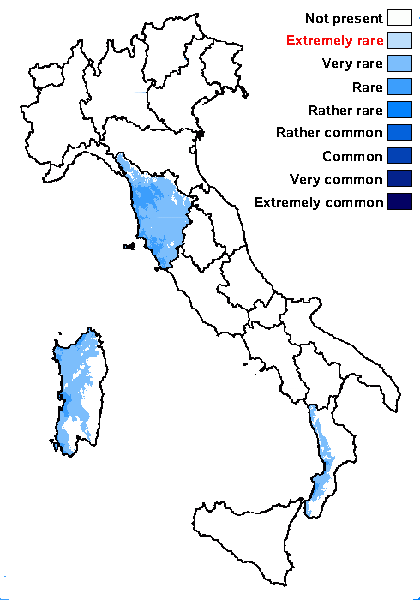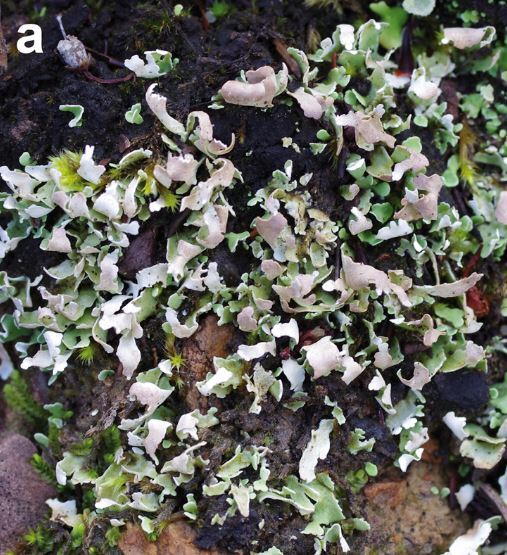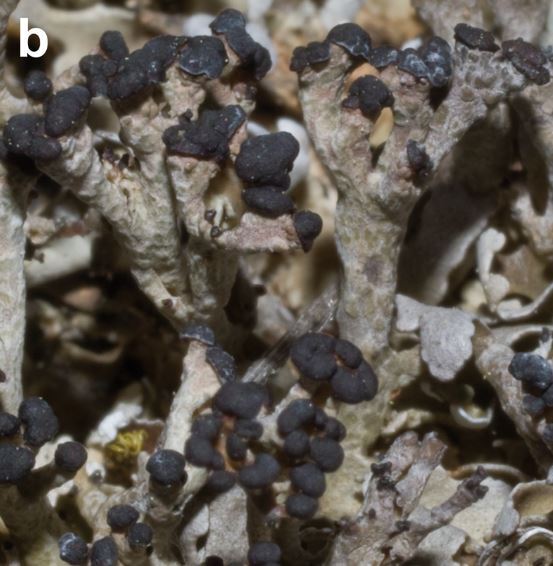Cladonia subturgida Samp.
Ann. Sci. Acad. Poytechn. Porto, 13: 38, 1916.
Synonyms: Cladonia iberica Burgaz & Ahti
Distribution: C- Tosc (Ravera & al. 2021), Sar (Pino Bodas & al. 2020). S. Cal (Pino Bodas & al. 2020)
Description: Primary thallus squamulose, persistent, the squamules characteristically fragile, large, (6-)12-25 mm long, 1.5-4 mm wide, with deeply lobed margins, olive green to greenish brown above, whitish to brownish (usually purplish towards tips) and very finely arachnoid beneath, sometimes darker near the attachment point. Podetia uncommon, pale green, 5-20 mm tall, 1-1.8 mm wide, digitately branched at apices, open laterally but twisted when dry, with open axils, corticate or ecorticate and granulose in upper part. Apothecia frequent, at the tips of podetia, dark brown, often coalescing into glomerules. Asci 8-spored, clavate, thickened at apex, with a K/I+ blue tholus and a K/I+ strongly blue outer gelatinous sheath, Cladonia-type. Ascospores 1-celled, hyaline, ellipsoid. Pycnidia at the surface or along the margins of squamules, sessile or pedunculate, ovoid to conical, constricted at base, with a colourless jelly. Conidia hyaline, curved. Photobiont chlorococcoid (Myrmecia). Spot tests and chemistry: six chemotypes (all of them C-, KC-, UV-): 1) K+ yellow, P- (atranorin); 2) K+ yellow, P- (atranorin, protolichesterinic acid and inconstant zeorin); 3) K+ yellow, P+ red (atranorin, protolichesterinic acid and fumarprotocetraric acid complex); 4) K+ yellow sometimes slowly tyrning brownish, P+ red (atranorin and fumarprotocetraric acid complex); 5) K- or K+ yellowish slowly turning brown, P+ red, (fumarprotocetraric acid complex and inconstant zeorin); 6) K- or K+ yellowish slowly turning brown, P+ red (fumarprotocetraric acid complex and protolichesterinic acid). Most frequent is chemotype 2).
Note: A long-neglected species, which appears to be fairly widespread in parts of the Mediterranean Region, on mineral clay soils within maquis vegetation, mostly over siliceous substrata. It should be looked for further, especially in Tyrrhenian Italy.
Growth form: Fruticose
Substrata: soil, terricolous mosses, and plant debris
Photobiont: green algae other than Trentepohlia
Reproductive strategy: mainly sexual
Most common in areas with a humid-warm climate (e.g. most of Tyrrenian Italy)
Commonnes-rarity: (info)
Alpine belt: absent
Subalpine belt: absent
Oromediterranean belt: absent
Montane belt: absent
Submediterranean belt: absent
Padanian area: absent
Humid submediterranean belt: very rare
Humid mediterranean belt: rare
Dry mediterranean belt: absent

Predictive model
Herbarium samples
Growth form: Fruticose
Substrata: soil, terricolous mosses, and plant debris
Photobiont: green algae other than Trentepohlia
Reproductive strategy: mainly sexual
Most common in areas with a humid-warm climate (e.g. most of Tyrrenian Italy)
Commonnes-rarity: (info)
Alpine belt: absent
Subalpine belt: absent
Oromediterranean belt: absent
Montane belt: absent
Submediterranean belt: absent
Padanian area: absent
Humid submediterranean belt: very rare
Humid mediterranean belt: rare
Dry mediterranean belt: absent

Predictive model
| Herbarium samples |
 INDEX FUNGORUM
INDEX FUNGORUM
 GBIF
GBIF



